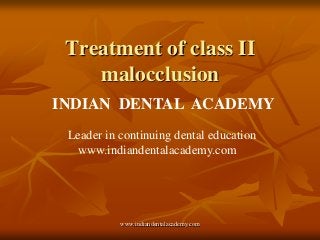
Treatment of class ii malocclusion1 /certified fixed orthodontic courses by Indian dental academy
- 1. Treatment of class II malocclusion INDIAN DENTAL ACADEMY Leader in continuing dental education www.indiandentalacademy.com www.indiandentalacademy.com
- 2. Introduction In class II malocclusion lower dental arch is in a distal or posterior relation to the upper arch as reflected by the first permanent molar relationship. The mesiobuccal groove of the mandibular first molar no longer receives the mesiobuccal cusp of maxillary first molar but usually contacts the distobuccal cusp of the maxillary first molar There are two divisions to class II malocclusion Class II Div 1 malocclusion –characterized by class II molar relationship with proclined maxillary anterior teeth Class II Div 2 malocclusion –characterized by class II molar relationship with retroclined upper centrals that overlapped by the lateral incisors www.indiandentalacademy.com
- 3. Etiology Prenatal factors- 1. Hereditary 2. Teratogens 3. Irradiation 4. Intra-uterine fetal posture Natal factors – 1.Trauma induced by improper forceps application during delivery . Trauma to condylar region lead to underdevelopment of the mandible Post-natal – 1.Traumatic injury to mandible and TMJ 2.Long term irradiation therapy of the skeletal cranio-facial region 3.Infectious conditions such as rheumatoid arthritis can influence mandibular growth 4. sleeping habits www.indiandentalacademy.com
- 4. Management of class II - Treatment principles depends on three important factors -: 1. the age at which patient is seen 2. the nature and severity of the problem 3. the underline etiologic factors Treatment objectives in class II div 1 malocclusion Reduction of overjet Reduction of overbite Correction of crowding and local irregularities Correction of unstable molar relationship Normalizing the musculature Correction of posterior cross bites if any www.indiandentalacademy.com
- 5. Treatment approaches 1. To prevent the malocclusion from occurring 2. To intercept a developing malocclusion 3. To correct already developed malocclusion 1. Management by preventing the etiological factors like functional disturbances, abnormal habits, etc. that would have contributed or exaggerated the class II malocclusion 2. Management by modifying the growth either by restricting the maxillary growth or enhancing the mandibular growth 3. If patient is seen after the growth period then camouflaging of skeletal jaw discrepancy by fixed mechanotherapy is the treatment of choice. It’s a compromise treatment for mild to moderate skeletal discrepancy 4. If the skeletal discrepancy is severe, then surgical intervention is the only alternative choice and should be undertaken after the cessation of growth. www.indiandentalacademy.com
- 6. Management of functional disturbances Mouth breathing - habit breaking appliance such as oral screen Abnormal tongue position and swallowing patterns -adequate motivation of the patient -habit breaking appliance ; fixed / removable -surgical reduction of abnormally large tongue - any other secondary causes, leading to nasal airway abstraction, should be looked for and eliminated Lip posture and activity Following Exercises suggested Patient should try to take the lower lip over the labial surface and try to exert a backward pressure Extending the lower lip over the upper lip or the reverse way and holding it as long as possible Holding the ice-cream stick between the lips and holding it as long as possible Button pull exercises all the above exercises are done a minimum of 30 minutes in divided period of five www.indiandentalacademy.com minutes
- 7. Management of abnormal habits like thumb sucking and finger sucking No intervention is needed until decidous teeth are erupted because they usually tend to stop by then Adult approach by giving a mature talk Reward system and reminder system suggested The offending digit can be painted with a pungent substance If all the above fails, then treatment by fixed or removable habit breaking appliances is the treatment choice www.indiandentalacademy.com
- 8. Management during mixed dentition Three important considerations are Age of the patient Location of the fault ( maxilla, mandible or combination ) Type of growth pattern (horizontal or vertical) www.indiandentalacademy.com
- 9. Management of maxillary prognathism with normal mandible Goal is mainly to restrict the excessively growing maxilla Manage by extraoral force using headgears Maxillary splint can also be used www.indiandentalacademy.com
- 10. Management of mandibular deficiency Goal is to enhance mandibular growth The appliances used are - Activator - Frankel - Herbst - & various other mandibular advancing devices www.indiandentalacademy.com
- 11. Management of dentoalveolar Class II malocclusion with normal skeletal relationship: 1. 2. 3. Based on etiological factors : Avoiding premature extraction and if necessary space should be maintained to prevent mesial drift of molars. In premature exfoliated cases where mesial drift has already occurred , space regaining devices like springs, screws or extraoral appliances for distalization of upper buccal segment can be done In cases where the upper and lower anteriors are proclined with spacing & deep bite, persistence of any abnormal habit like : thumb sucking , cheek sucking etc. should be looked for and eliminated before retracting. www.indiandentalacademy.com
- 12. Management of Class II malocclusion in adults: Dentoalveolar compensation for the skeletal defect through reduction of tooth material is the treatment of choice. Dentoalveolar is brought about by various multibanded appliance therapies. Class II malocclusion can also be treated by various orthognathic surgeries www.indiandentalacademy.com
- 13. Treatment objectives of Class II Div 2: 1. 2. 3. 4. Relief of gingival trauma Correction of incisor relationship Relief of crowding & local irregularities Correction of buccal segment relationship www.indiandentalacademy.com
- 14. Management of Class II Div 2: In mixed dentition phase: Maxillary anteriors can also be proclined by functional appliance. Reduction in incisal overbite by use anterior bite plane or fixed appliances incorporating anchor bends or reverse curve of spee. www.indiandentalacademy.com
- 15. Thank you For more details please visit www.indiandentalacademy.com www.indiandentalacademy.com
